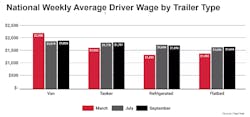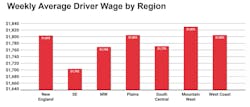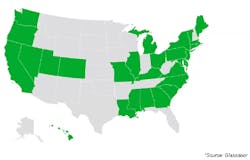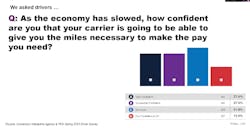As inflation places upward pressure on wages and a sluggish freight market drags down rates, recruiters must keep their fingers on the pulse of driver pay to attract drivers looking for the best way to make ends meet, according to two pay and recruitment experts.
Average driver pay increased about 18% from 2019 to 2021, according to Steve Sichterman, vice president of Fleet Intel, a company that collects and analyzes pay and benefits data for carriers. A 10% increase occurred in 2021 alone.
"2022 started off with a bang as well. We saw referral bonus pay being increased by upwards of 10%. And according to the industry, 90% of carriers in 2021 raised pay," Sichterman said during a Truckload Carriers Association webinar this week.
It's not just what you pay truck drivers but where you pay them
"One of the things that changed, particularly over the last four years, has been the idea of how we pay drivers," Sichterman said, "from the standpoint of how we're paying drivers based on where they live."
Some of the highest-paying markets for drivers, according to Sichterman, are New Mexico, Massachusetts, and Des Moines, Iowa, at $1,842, $1,835, and $1,830 weekly averages, respectively.
See also: How to up your hiring game
Sichterman asserted that the days of having a single homogenous pay package across the country are long gone if you want to be competitive.
"It's important that, from a sales leader standpoint and operations leader standpoint, you understand what those numbers are in a particular market," Sichterman said, "so that you also not only can be competitive when you're trying to fill those seats for the drivers that you need but also that you're competitive and being able to make money on runs."
In pay discussions, be transparent and tailor talks to the individual
"The one thing I would caution here," Sichterman said, "is in the states that have pay transparency laws, be very careful that you're not just putting out what your top 10 earners make. That could potentially lead to some problems for you. You want to make sure that you're talking about what your average is making—but there's nothing wrong with talking about what the top 10 make as well to show them what they could potentially do."
See also: Look outside HR for employee retention tips
Norlin urged recruiters to discuss the entire compensation package, including benefits and home time when speaking with drivers about pay.
"So many times, drivers are fixated on cents per mile, and there's so much more to a driver compensation package than cents per mile," Norlin said, adding that Roehl Transport recruiters typically discuss average weekly pay before cents per mile.
Recruiters at Roehl will walk through the entire compensation package—especially health benefits—which often sways drivers from a different carrier that pays a penny or two more a mile because our Roehl's benefits are good, Norlin said.
Home time is another important perk for recruiters to discuss as drivers increasingly want an improved work-life balance, according to Norlin.
"You have to ask them what's important. If getting home every Friday at five is important, your overall average is probably going to be a little bit less," Norlin said. "Be honest with the drivers and share. You might miss out on some drivers, but I'd rather our recruiters don't bring someone in under false pretenses and promise them something that is not going to happen."
See also: To attract job seekers, give them what they want
Are truck drivers getting enough miles?
In spring 2023, Fleet Intel polled almost 1,600 drivers on whether they were confident that their carriers could offer enough miles for the drivers to meet their needs. Half were confident that their fleets would be able to, but almost one-third were unsure, and 13% were not confident. Both Sichterman and Norlin expect, when the next poll data releases, even more drivers will lack confidence in their carriers' abilities to provide enough miles.
Norlin said recruiters must have accurate, up-to-date information, which is why Roehl Transport analyzes its driver pay every month. He also stressed the importance of tailoring compensation discussions to each driver.
He gave the example of hiring a 10-year veteran driver. In that pay conversation, it would be wise for the recruiter to share information not only on average weekly pay but on pay for the top-earning drivers because seasoned drivers are likely to reach the upper echelon of pay. For rookie drivers, he suggests simply sharing average weekly earnings.
See also: Driver recruiter seeks to build tight-knit fleet
Norlin also said that Roehl Transport did away with sign-on bonuses three years ago and that company employees "haven't missed it at all."
"We rolled that into the driver wages, and we've not looked back," Norlin said. "A majority of drivers, I think, look at sign-on bonuses as a gimmick, and a lot of hoops to jump through to get it. Yes, it does attract a certain group of drivers to you, but are those the drivers you want to attract?"
Norlin acknowledged that sign-on bonuses can still be helpful for some carriers with an immediate need for driver interest. However, a large bonus spread over 12 to 18 months is not appealing to drivers.









